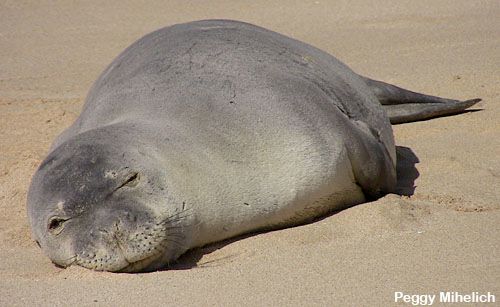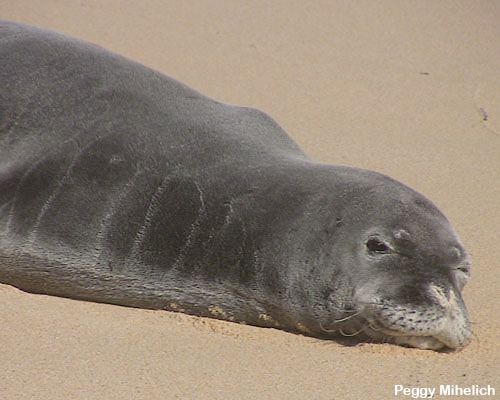





Pila’a Beach is a remote area on the north shore of Kauai, the fourth largest of the main Hawaiian Islands. It is a common resting spot for Hawaiian monk seals, an endangered species.
RK-06, a healthy adult female monk seal was a Pila’a regular. She spent her days as most monk seals do – foraging in the shallow waters at night, sleeping on the quiet beach by day.
On May 21, 2009 a couple just arriving in the beach parking lot saw a man standing next to a pickup truck. Then they heard gunfire. As they looked to see what he was shooting at, a large Hawaiian monk seal limped slowly into the sea. Not long after, the couple found the dead seal’s body floating in the water.
RK-06 was the mother of five pups, a month from giving birth to her sixth, when she was shot four times at close range with a high-powered rifle. One round hit her side and landed in the womb next to her full-term fetus. Another bullet went through her lung and pierced her heart.
In less than a year, there were three reported monk seal killings on the main Hawaiian Islands. On April 19, RK19, a 5-year-old adult male seal, was found shot to death on Kauai’s west side. On December 14, the body of R019, a large male monk seal, washed up on the island of Molokai.
In the midst of the savage killings, a young monk seal, raised in captivity and released into the wild, swam into Kaunakakai Wharf on the island of Molokai and started playing with the local children.
Fearing for his safety, wildlife officials relocated the seal, known as KP2, 40 miles from the harbor. But two days later, KP2 swam back. Next, officials asked people to stop swimming with him in hopes he’d leave on his own. That didn’t work, either.
In early September, KP2 was swimming with an elderly woman when he grabbed her from behind and held her under the water. She was frightened by the seal’s behavior. Wildlife officials took the seal to an aquarium, angering the local community.
These two dramatic episodes while different, illustrate a growing problem: humans and wildlife competing for limited resources.
For over two decades the Hawaiian monk seal has steadily marched toward extinction. There are just 1,100 Hawaiian monk seals alive today and their ranks are dwindling. A fraction of them — 150 animals — live on the main Hawaiian Islands. These seals rest on popular beaches and forage for food alongside fishing boats and divers. Most Hawaiians are happy to have them around. But fishermen, who compete most directly with the seals, feel their livelihood is threaten. They say the seals are invasive and steal their fish. Many fishermen want the seals eradicated. Wildlife officials counter the animals are native and too small in number to impact human subsistence.
It is a familar story heard around the globe. On the Great Plains of the U.S., the black-tailed prairie dog population, like the Hawaiian monk seal, is declining because of longstanding hatred from the ranching community. In Uganda, primates in Kibale National Park compete with local communities for territory and resources.
The fate of wildlife depends on human tolerance for them.
Building a balance in Hawaii for the monk seal rests with a small group of federal workers and volunteers. They are up against a shrinking population of seals, a small budget, and alienated fishermen who feel their way of life is slipping away.
If this group of monk seal advocates can forge a peaceful coexistence between seals and humans, their success could prevent the seals’ demise and help other wildlife in similar circumstances. If they can’t make it work, the Hawaiian monk seal may be the next extinction because of human actions. (Read Chapter 2)